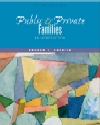EXERCISE 1 A great deal of information on children-especially disadvantaged children-is
available on the Internet. For instance, a report mentioned in the "Measuring
the Well-Being of Children" essay in this chapter, Trends in the Well-Being
of America's Children and Youth, 2000, issued by the Office of the Assistant
Secretary for Planning and Evaluation of the U.S. Department of Health and Human
Services, was available in 2001 at (http://aspe.hhs.gov/hsp/00trends/index.htm.)
A more recent volume may be available. Other resources include the National
Center for Children in Poverty at Columbia University (http://cpmcnet.columbia.edu/dept/nccp),
which maintains a web site with several well-done reports about child poverty
(click on "Child Poverty Facts"). Browse some of the fact sheets and
tables at these sites to get a sense of recent trends in child poverty. EXERCISE 2 Monitoring the Future (www.monitoringthefuture.org) is an annual
survey of 8th, 10th, and 12th grade students, undertaken by the University of
Michigan's Institute for Social Research. The survey includes information about
drug and alcohol usage and cigarette smoking (click on "Data Tables and Figures").
What were the trends in drug usage by teenagers in the 1990s, according to this
study? EXERCISE 3 - Alternate Families and the Media There are magazines for every social category of people, and alternative families are no exception. Alternative Family (http://www.altfammag.com) is a magazine for gay, lesbian, and bisexual parents with advice on raising children and dealing with the everyday challenges of life in homosexual households. Visit this site and click on Current Issue on the banner at the top. Take a look at the table of contents. Read an article or two. What kinds of issues are under discussion? Would you say the magazine's position is pro- or anti-family? How different are these articles from ones in a traditional family magazine such as Parents (http://www.parents.com/)? EXERCISE 4 - How Involved Are Fathers in Raising Kids? Most couples today agree that dads should be as involved in raising their kids as moms. How common is it that they actually are? The Population Reference Bureau has collected some data on this issue. See their site at http://www.prb.org/. Find the menu on Browse Topic on the right, and click on Marriage and Family. Scroll down to "How Involved Are Fathers in Raising Children?" and click on read article. Answer the following: 1. What are the attitudes of men and women quoted in the study about parents' involvement in childrearing? 2. How do their reported behaviors compare to their attitudes? In what areas do moms and dads show the most distinct patterns of responsibility for childrearing? | 


 2002 McGraw-Hill Higher Education
2002 McGraw-Hill Higher Education